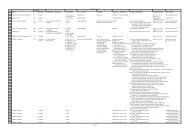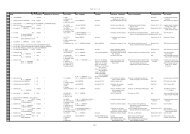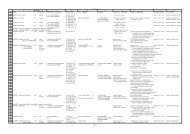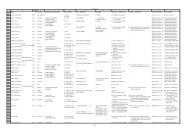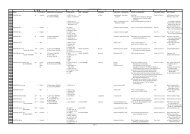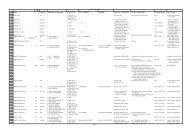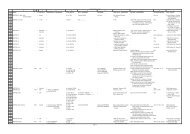You also want an ePaper? Increase the reach of your titles
YUMPU automatically turns print PDFs into web optimized ePapers that Google loves.
78<br />
79<br />
80<br />
81<br />
82<br />
83<br />
84<br />
85<br />
86<br />
87<br />
88<br />
89<br />
90<br />
91<br />
92<br />
93<br />
94<br />
95<br />
96<br />
97<br />
98<br />
99<br />
100<br />
101<br />
102<br />
103<br />
104<br />
105<br />
106<br />
107<br />
108<br />
109<br />
110<br />
111<br />
112<br />
113<br />
114<br />
115<br />
116<br />
117<br />
118<br />
119<br />
120<br />
121<br />
122<br />
123<br />
124<br />
125<br />
126<br />
127<br />
128<br />
129<br />
130<br />
131<br />
132<br />
133<br />
134<br />
135<br />
136<br />
137<br />
138<br />
139<br />
140<br />
141<br />
142<br />
143<br />
144<br />
145<br />
146<br />
147<br />
148<br />
149<br />
150<br />
151<br />
152<br />
153<br />
154<br />
Invent; <strong>Swinton</strong>, <strong>John</strong> 1699.xls<br />
A B C D E F G H I J K L<br />
From during this campaign there is a story of notoriety that took place at the English court involving two ladies. There were times when <strong>John</strong> de <strong>Swinton</strong> was at<br />
Lancsater's Court. As well as a soldier and politician, Lancaster was fond of music, Chaucer was a close friend, <strong>John</strong> Wycliffe, the religious reformer was his<br />
honoured guest. He gave great gifts of gold and silver plate, costly raiment and furs and above all jewels (pearls, diamonds, rubies, saphires & emeralds), which<br />
were the craze of the time. <strong>John</strong> de <strong>Swinton</strong> was involved with a lady at the Court - Joan. She was aparently a wife to <strong>John</strong> but while he was away at war she<br />
died at Court leaving no issue. At Court is Alice Perrares, a mistress to the King, Edward III, who is 'not only a scandal and danger to the realm but a<br />
notable jewel thief'. On Joans death, '<strong>John</strong>'s rubies and pearls, more probably the spoil of his viage through France than the heirlooms of a Border family' are<br />
stolen by Alice Perrares for they '…pass into her treasure chest'. The jewell's were valued at £400 (k). Though the deputies of Richard II were petitioned, and they<br />
were prepared to see justice done, its they doubted whether the jewels could be traced. (e) <strong>John</strong> was known as a collector of fine jewellery - rubies, pearls and diamonds.<br />
In 1375 Lancaster went to France as ambassador, securing a truce. He was however gaining a reputation as an unlucky and expensive general, rapidly losing popularity.<br />
1376, June, the King died, then following Wycliffe's trail (1377, Feb. 20) Lancaster was forced to fle his palace of the Savoy in London, escaping to Kennington. (e)<br />
1377 : <strong>John</strong> de <strong>Swinton</strong> decided to return to Scotland. King Richard II issued a'Warrant for safe conduct till the last days of April for Sir <strong>John</strong> de <strong>Swinton</strong>, with<br />
60 men … to pass through Normandy, take ship at Harfleur … for Southampton … thence to the King's presence … and thereafter to Scotland'. Not so many years<br />
before he travelled with 'one man at arms and three archers'. (e)<br />
1377: In this year (perhaps) the King's advisers were ready to restore to <strong>Swinton</strong> lands to a rightful owner, especially when it was a respected friend who could<br />
be expected to keep the peace in these trouble border lands. Perhaps the possinle return of the lands was a reason why <strong>John</strong> had served for the past six years.<br />
Initially there was trouble when he arrived back in Scotland for he found that another member of the family, Henry de <strong>Swinton</strong>, probably an uncle, had already<br />
arrived from Abernethy in Perthshire and taken possession. The question of who was the rightful owner following the forfeiture, for one was styled 'Lord<br />
of <strong>Swinton</strong>', the other 'Lord of that Ilk', was resolved when William, Earl of Douglas produced other lands (Mykery, Barony of Strathurd, Sheriffdom of<br />
Perthshire)which Henry accepted in 'amicable exchange'.<br />
1377: During the uprisings in London the citizens vented their fury against the Lancasters. While "stray retainers of the Duke (<strong>John</strong> of Gaunt) found it prudent to<br />
hide their badges; one, braver or less prudent than the rest, who refused to hide the proud emblem of the Lancastrian retinue, was badly mauled by the<br />
mob who dragged him from his horse and tore the badge of Lancaster from his neck" (l)<br />
In the early period <strong>John</strong> probably still spent much time in England and had dealings with London; William Calle owed <strong>John</strong> £40 and was outlawed until he paid it. (e)<br />
<strong>John</strong> continued to be retained by Lancaster, appearing in his Register - 'On the 2nd November, 1379, the Duke writes from Kenilworth that he [<strong>John</strong>] is to be given sixty<br />
pounds which are owing to him; and again, on 23rd August, 1380, there is an order from Tutlebury that [the] "bacheler Monsire Johan Swynton" is to be paid his annuity'.(e)<br />
The Duke of Lancaster (<strong>John</strong> of Gaunt) was appointed at Ayton on 12 May 1379 to make a diplomatic mission to the north. Through out England peasant had risen<br />
the poll tax. In June while at Coldingham, Wat Tyler led a group of Kentish rebels entered London plundering and burning the houses of the great. At this<br />
time Lancaster's Savoy palace 'was in ashes'. The gates of Bamburgh were shut in Lancaster's face and he was forced to take refuge in Edinburgh<br />
for a month until the storm blew over.<br />
1379, July 12: Lancaster made a proclaimation at Berwick in which it appears that <strong>John</strong> de '<strong>Swinton</strong> was installed as a peacemaker in the Marches'.<br />
1380, June 4: [No. 28] Instrument and Act of Transcript obtained before William de Haleburton, baillie of Haddington, of a charter under the great seal<br />
granting <strong>John</strong> de <strong>Swinton</strong>, knight £20 sterling yearly until he was infeft in £20 of land (f)<br />
1382, June 4: King Robert II of Scotland granted Sir <strong>John</strong> 'and his heirs a pension of £20 a year'. (e)<br />
1382, Oct 30: gains lands of Meikle <strong>Swinton</strong> confirmed by King Robert II & <strong>John</strong>, Earl of Carrick. From the earliest days the <strong>Swinton</strong> lands had been divided.<br />
'Parva [Little ?] Swyntona' was held by the family, but'Meikle Swynton, the township, was a possession of the Monks of Coldingham'.<br />
In 1382 the Abbot of Dunfermline handed over the lands of Meikle <strong>Swinton</strong>, the gift receiving Royal confirmation, and with Pope Clement VII,<br />
'fortifying a transaction' as significant 'ass the surrender of Church lands by a papal Bull' (e) dated 1383, June 4 [Bull of Confirmation by<br />
Pope Clement VII of Charteds 4, 5, and 7 given at Avignon]. {According to George S.C. <strong>Swinton</strong> this transaction for little (Mickle) <strong>Swinton</strong> was<br />
concluded in 1379. <strong>John</strong> had to hand over an equivalent value in other lands.<br />
Before 1387, August: Sir <strong>John</strong>, now styled Lord of tha Ilk, married Margaret, 'Countess of Mar', widow of William, first Earl of Douglas who died in 1384.<br />
Through this marriage to Countess Margaret Douglas he acquired an additional 'courtesy' title of Lord of Mar;<br />
1387: James, Earl of Douglas & Mar, handed over to his step-father the lands of Tillicoultry in Clackmannan, and Clova in Angus which King Robert II confirmed.<br />
Thomas of Erskine went before the King in 1390 expressing concerns over the transaction on the lands to which his wife Issabell had rights, claiming that<br />
these rights should not be prejudiced. The King agreed and though Sir <strong>John</strong> perhaps enjoyed Tillicoulty & Clova during his life, they did not pass to his heirs. (e)<br />
1388, Aug.: engaged in the Battle of Otterburn. If john had scruples about taking up arms against his English comrades then the fact that Lancaster was<br />
away in Portugal and his step-son, James of Douglas managed to break them. James, Earl of Douglas, and Sir <strong>John</strong> rode together, first to Melrose where <strong>John</strong><br />
witnessed a charter confirming the church of Cavers to the Abbey [of Melrose ?]. They then rode on to England and battle and Scottish victory. Chroniclers who<br />
were present give less credit for the vitory to'the dead Douglas then to his stalwart step-father' [Sir <strong>John</strong>]. 'The younger man [James, Earl of Dougla], in his<br />
haste insecurely armed, striking out right and left with his battle-axe, fell early in the frey, unrecognised, borne down by three lances fixed in his body'.<br />
At battles end Harry Hotspur (Sir Henry Percy) (d) and his brothers, the sons of Lancaster's old ally, Henry Percy, were prisoners. (e)<br />
1389, Dec. 5: with the death of his step-son James, 2nd of Douglas & Mar, there was no 'rightful heir' to the Douglas earldom. Most of it went to Archibald the<br />
Grim while Cavers went to one of James 'natural' [illegitimate] sons and Drumlanrig to another. 'Perhaps it was feared that <strong>Swinton</strong> and his wife might lay<br />
claim to this last' for on this date <strong>John</strong> signed a document [still in the charter-chest at Drumlanrig] that '<strong>John</strong>e of Swyntoun, Lord of Mar, and Margaret, his<br />
spous, Countes[s] of Douglas and Mar …… say Witt[ness] ye us of ane [one] mynd consent and assent, to hef [have] faithfullie promist to William Douglas, sone<br />
to umquhile James Erle of Douglas (whom they later call 'our sone') that we shal nevir in onywayes [anyway] move any question or contraversie [controversy]<br />
against him …… concerning the baronie of Drumlanrig ……' etc (e)<br />
Attached to this document (1389) is attached the only impression of Sir <strong>John</strong>'s seal that is know to exist. This seal is illustrated in A.C. Fox-Davies<br />
"A Complete Guide to Heraldry", Thomas Nelson & Sons 1969, page 387. It is worth noting 'that the helmet, coronet and crest are the exact counterpart<br />
of the great Garter-plate, in St. George's Chapel at Windsor, of his contemporary, Ralph Lord Basset of Drayton'. (e)<br />
1390-92: Around this time his wife, Margaret, Countess of Douglas & Mar died.<br />
1391: King Robert III repays Sir <strong>John</strong>150 gold nobles (1919 = £62 10s) which he had been borrowed. Perhaps Sir <strong>John</strong> had lent money to the heir to the throne<br />
to be repaid when he succeeded.<br />
1391, March: Sir <strong>John</strong> was appealed to by the Prior of Durham in a letter asking for his help which must have been given, a latter letter gives grateful thanks. (e)<br />
1391, Nov. 14: A safe-conduct was issued for '<strong>John</strong> <strong>Swinton</strong> of Scotland' and 30 persons, 'all unarmed', to travel to [London ?]. (e)<br />
1392, March: King Robert III confirms to <strong>John</strong> the '£20 pension granted by his late royal father.' (e)<br />
c1392: Sir <strong>John</strong> married a third time to Lady Margaret Stewart, [most likely the] daughter of Robert Stewart, Earl of Fife, Duke of Albany, and<br />
the Regent fron 1406-19; grandaughter of King Robert II.<br />
1392, July 24: <strong>John</strong> was appointed ambassador extroadinary to Eng. (d) by King Robert III to negotiate a treaty with the Court of England, for which they got safe<br />
conduct for their retinue, including 60 knights. This 'Embassy' set up to negotiate border relations was made up of 'Johannem de Swynton. Henricum de<br />
Douglas, Johannem de Saintcler, Henricum de Preston [and] Johannem de Dalzell'. The negotiations must have been successful, peace continued for 10 years. (e)<br />
1395, May 27: <strong>John</strong> "a true patron of the church" had presented <strong>John</strong> Simon to Adam, Bishop of Aberdeen, to take over the parish church of<br />
Cadylston left vacant by the late William Fraser (g)<br />
1397, Oct: A further meeting was at Hawdenstanke, near Birgham which the Duke of Lancaster attended, after which he took no further part in public affairs.<br />
Lancaster died the following year. While <strong>John</strong>'s presence is not recorded at this meeting it is significant 'that two months later his services are<br />
acknowledged in England, by a grant …… of the pesage of the wool at Scarborough.' (e)<br />
1399: South of the Tweed there was revolution taking place. Henry of Hereford, son of <strong>John</strong> of Gaunt, E. of Lancaster, forced King Richard II to abdicate and<br />
was crowned King Henry IV. Henry was married to Elizabeth of Dunbar, daughter of the Scottish (George, 10th Earl of Dunbar and 3rd & last ?) Earl of March.<br />
Page 2



